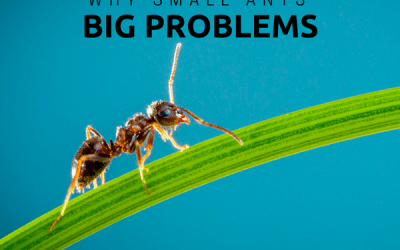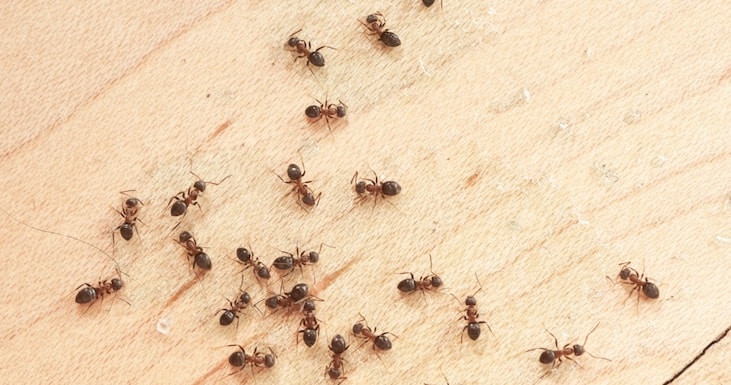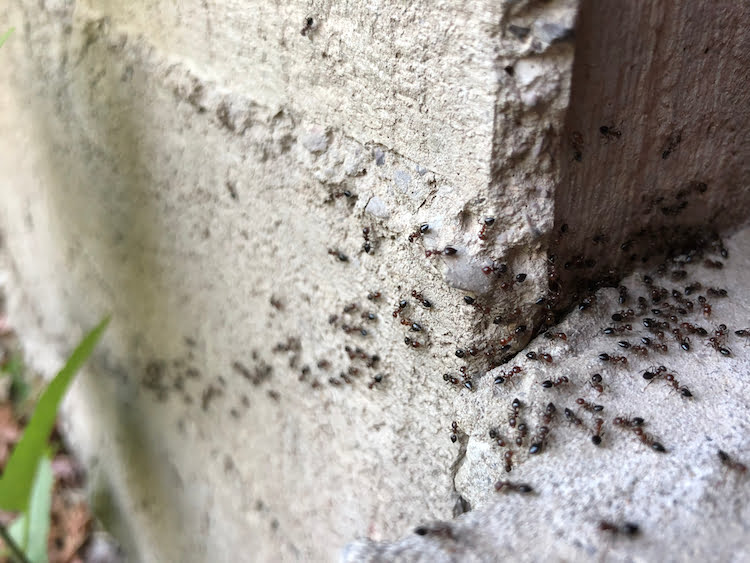Ant problems are typically caused by easy access to food and shelter. Environmental changes often send ants indoors seeking refuge.
Ant infestations are a common issue that many homeowners encounter, and addressing the root causes is essential for effective control and prevention. These tiny invaders are drawn to any available food sources, which can include crumbs, spills, and accessible garbage.
Ensuring cleanliness is therefore pivotal. Ants also seek out environments that provide moisture and protection, such as damp areas and cracks in walls or foundations. Regular maintenance and sealing of potential entry points can drastically reduce the likelihood of an ant problem. With a clear understanding of these triggers, homeowners can take proactive measures to deter ants and maintain a pest-free home.

Credit: ecoclearproducts.com
The Basics Of Ant Infestations
Ant problems in homes often start small. A few scouts can lead to a huge colony. Understanding how they invade is key. Let’s explore the common species and how they thrive socially.
Common Species That Invade Homes
Several ant species prefer our cozy homes. Notable invaders include:
- Odorous House Ants – Leave a foul smell when crushed.
- Carpenter Ants – Damage wood structures profoundly.
- Pavement Ants – Commonly seen on sidewalks and foundation edges.
- Pharaoh Ants – Notorious for spreading disease.
Lifecycle And Colonies: The Social Structure
Ant societies are well-organized. Here’s a snapshot of their social structure:
| Role | Description |
|---|---|
| Queens | Primary role is to lay eggs. |
| Workers | Infertile females, doing the foraging and feeding. |
| Males | Purpose is to mate with the queen. |
| Larvae | Grow into one of the above roles. |
Understanding these roles is essential. It helps us tackle infestations effectively.
Ants And Their Search For Resources
Ant infestations can leave homeowners in distress. These tiny creatures possess incredible abilities to locate food and water. This section delves into why ants invade our spaces, focusing on their search for vital resources.
Craving For Sugars And Proteins
Ants are not random in their quest; they have specific tastes. A kitchen spill or an unsealed jar of jam is not just a mess. To ants, it’s a call to feast.
- Sweet spills attract ants.
- Protein-rich substances are ideal for their larvae.
- Even small crumbs can invite a swarm.
Pet food bowls are often unnoticed resource goldmines for ants. Keeping these areas clean is crucial.
Water Sources: Sinks, Pots, And Drips
Water is life—not for humans alone. Ants need it too. A dripping faucet or a wet countertop might be the water source an ant colony needs.
| Location | Contribution to Ant Problems |
|---|---|
| Kitchen Sinks | Pooled water |
| Plant Pots | Overwatering drips |
| Bathroom Leaks | Constant moisture |
Regular maintenance of indoor and outdoor water sources can prevent an ant invasion.
Human Habits That Attract Ants
Ants invade our homes for many reasons. They search for food, water, and shelter. Our homes provide these needs. We may unknowingly invite them inside. The way we store food and clean our spaces matters.
Improper Food Storage
Ants have a strong sense of smell. They find food from far away. Food left out becomes a target. Keeping food sealed is important. This means using airtight containers. Refrigerating perishables also helps.
Think about these simple steps:
- Seal your cereals and grains.
- Use containers that lock tight.
- Keep fruits inside the fridge.
- Do not leave pet food out.
Proper storage looks like this:
| Food Type | Storage Method |
|---|---|
| Grains | Sealed containers |
| Fruits | Refrigerator |
| Leftovers | Airtight wraps |
Lack Of Regular Cleaning
Crumbs and spills attract ants. Quick cleanup prevents this. Floors and surfaces need regular care. Daily sweeping stops ants from finding leftovers.
Key cleaning tasks include:
- Wipe counters after use.
- Vacuum crumbs regularly.
- Clean up spills right away.
- Empty trash bins often.
A clean routine might be:
Morning - Sweep kitchen.
After meals - Wipe surfaces.
Night - Take out trash.
:max_bytes(150000):strip_icc()/how-to-get-rid-of-ants-2656468_final-51f2d2e263c1482fa95ec6529a107971.png)
Credit: www.thespruce.com
Outdoor Ant Attractants
Ant issues in your yard or garden are often due to outdoor attractants. Understanding what draws them can help you prevent infestations. Let’s look into common factors triggering ant problems outdoors.
Gardens And Plants: A Double-edged Sword
Your lush garden could be an ant paradise. Plants attract ants because they provide shelter, moisture, and food. Sap-sucking pests like aphids produce honeydew, a favorite for ants. Here are ways your garden might be inviting ants:
- Sweet-smelling flowers can allure ants.
- Moist soil is perfect for ant colonies.
- Aphids on plants lead to more ants.
Keep gardens well-maintained to reduce ant attractants.
Garbage Disposal And Composting Practices
How you through away scraps plays a big role. Ants are attracted to food waste and composting areas. Tips for managing waste include:
| Practice | Benefit |
|---|---|
| Sealing bins | Limits ant access |
| Regular cleaning | Removes food residue |
| Proper composting | Prevents odors that attract ants |
By adopting better garbage disposal and composting habits, you can significantly reduce outdoor ant problems.
Structural Issues And Ant Entry Points
Ant problems in homes often stem from structural issues that provide easy access. Tiny invaders may seem harmless, but they can be persistent and annoying. Understanding structural issues and ant entry points is crucial for keeping them out. Let’s dive into common structural vulnerabilities these creatures exploit to enter our homes.
Cracks In Walls And Foundations
Cracks can appear over time due to weather, settling, or construction flaws. Ants need only the smallest of openings to infiltrate a home. A fissure as thin as a credit card width is a welcome mat for an ant. Regular inspections for signs of damage can significantly reduce the risk of infestation.
- Check exterior walls for fine cracks.
- Seal any openings with appropriate caulk or sealant.
- Monitor for new cracks as seasons change.
Gaps In Windows And Doorways
Gaps often occur where windows and doors meet their frames. These gaps are prime entry points for ants seeking shelter or food. Simple fixes can block these pest pathways.
- Inspect window and door frames regularly for gaps.
- Replace old or worn weather-stripping.
- Consider door sweeps to cover gaps below doors.
Addressing these structural issues can greatly reduce ant problems. Vigilance and maintenance are the keys to a pest-free home.
Climatic Conditions Favoring Ant Infestations
Ants are not just determined by their endless search for food. The climate plays a huge role in their behavior. When conditions outside get tough, your home looks like a safe haven for these tiny invaders. Let’s explore how weather patterns contribute to ant problems.
Moisture And Rainfall Patterns
Increased moisture is a major draw for ants. High rainfall levels often push them to seek shelter. They need dry grounds for their colonies. Your home’s consistent climate is perfect for them.
- Heavy rains flood ant nests.
- Ants move indoors to escape saturation.
- Damp wood in structures appeals to them.
Temperature And Seasonal Changes
Ants are sensitive to temperature changes. As winter turns to spring, their activity spikes. They venture out to gather food and establish new colonies. Your warm home remains a target during cooler months too.
| Season | Ant Activity |
|---|---|
| Spring & Summer | High foraging; colony building |
| Fall & Winter | Searching for warmth and food |
Remember, extreme heat or cold can also drive ants inside.
The Role Of Scent Trails In Ant Invasions
Ants may be tiny, but they are mighty navigators thanks to their secret weapon: scent trails. These trails are invisible pathways that guide entire colonies to food, water, and shelter. Understanding the role of scent trails is key to tackling ant problems in homes and gardens.
How Ants Communicate And Navigate
Ants use a sophisticated language of chemicals to talk to each other. This communication guides them to food sources back to the colony.
- Ants release pheromones, which are special scents.
- Other ants sniff these pheromones with their antennas.
- These scents form trails that create paths for other ants to follow.
Disrupting Ant Trails To Prevent Infestations
Breaking the chemical communication can stop ants in their tracks. Without these trails, ants can’t find their way to food sources. This method is effective in preventing ant invasions.
| Method | Description | Application |
|---|---|---|
| Vinegar Solution | Erases pheromone trails | Spray on ant paths |
| Chalk Lines | Creates a barrier | Draw near entry points |
| Essential Oils | Overpowers scent trails | Apply at entry points |
Cleaning regularly can also disrupt scent trails. Wipe down surfaces and vacuum floors to remove any lingering pheromones.
To conclude, breaking scent trails can keep ants away. It’s a simple and natural solution to ant problems.
Professional Vs. Diy Ant Control Methods
Battling an ant invasion often boils down to two main approaches: Professional or DIY ant control. Each has its perks and drawbacks. Spotting the difference helps decide the best way to handle these persistent pests.
When To Call The Experts
Expert ant control comes into play when infestations spiral out of hand. Consider signs that signal the need for professional intervention:
- Large Colonies: Seeing trails of ants or multiple nests? Pros can tackle it.
- Repeat Offenders: Are ants coming back despite DIY efforts? Call the experts.
- Property Damage: Notice structural harm or wood shavings? Might be carpenter ants.
- Health Risks: Worried about allergies or bites? Specialists ensure safety.
Effective Home Remedies And Prevention Tips
For those minor ant problems, DIY methods often suffice. Here are some easy-to-use home remedies and tips for keeping ants at bay:
| Home Remedy | Instructions | Prevention Tips |
|---|---|---|
| Vinegar Solution | Mix equal parts water and vinegar. Spray on trails. | Keep counters and floors clean. |
| Borax Bait | Combine borax and sugar. Place near entry points. | Seal cracks and crevices. |
| Cinnamon Sticks | Place sticks where ants enter. | Avoid leaving food out. |
Ant issues can feel overwhelming, yet they’re often manageable with the right approach. Simple solutions include keeping areas clean and using natural deterrents like vinegar. Remember, consistent effort in prevention goes a long way towards a pest-free home.

Credit: www.enviroconpest.com
Frequently Asked Questions For What Causes Ant Problems
What Attracts Ants Into My Home?
Ants are often lured indoors by accessible food sources and moisture. Crumbs, spills, pet food, and even overripe fruit can attract ants. They also seek water, so leaky pipes and standing water are attractants.
How Can I Prevent An Ant Infestation?
Prevention includes maintaining cleanliness to eliminate food particles, sealing entry points, and managing moisture. Store food in airtight containers, wipe down surfaces, use ant repellents, and fix leaks promptly.
Why Do Ants Suddenly Appear In Houses?
Sudden ant appearances typically coincide with a change in weather or the search for resources. Ants may invade homes during dry seasons for moisture or after rain to escape flooding.
Do Ants Cause Damage To My Property?
While most ants are nuisance pests, some species, like carpenter ants, can cause structural damage. They excavate wood to create their nests, which can weaken wooden elements over time.
Conclusion
Ant infestations can stem from multiple factors. Understanding the root causes, such as accessible food sources or moisture, is crucial. Implement preventive measures and maintain cleanliness to deter these persistent invaders. For persistent issues, professional extermination might be necessary. Remember, controlling ant problems starts with addressing their basic survival needs.

I’m MD Tanvir, and I bring years of expertise gained from working closely with pest control companies to the forefront. My journey in the industry has inspired me to launch Bug Battler, a platform aimed at equipping people with the know-how to combat pests autonomously. Through Bug Battler, I aim to empower individuals with practical insights to tackle pest infestations effectively.

